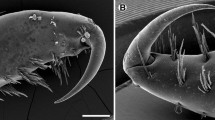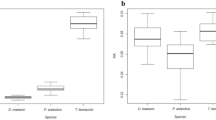Abstract
The functional morphology and feeding behavior of Paraprionospio pinnata (Ehlers) were studied. The tentacular feeding palps of P. pinnata possess four groups of cilia: laterals, latero-frontal cirri, frontals and basal transverse rows. The lateral cilia beat in metachronal waves creating in current that flows toward the frontal surface of the palp. The latero-frontal cirri deflect suspended particles onto the frontal surface and potentially resuspend deposited particles. The frontal cilia line the groove of the palp and transport particles to the ciliated pharynx. The basal transverse cilia also beat in metachronal waves and together with the frontal cilia of the branchiae produce a “U”-shaped current that removes particles rejected by the pharynx from the burrow. The significance of particle selection at the site of the pharynx in spionid polychaetes is hypothesized to be constrained by the interaction of specific morphologies and behaviors that reduce the effects of epifaunal predation and browsing. The relationship between sediment permeability and type of respiratory or ventilation current is hypothesized to be a potentially important factor in understanding the distribution of spionid polychaetes.
Similar content being viewed by others
Literature cited
Banse, K.: The small species of Euchone Malmgren (Sabellidae, Polychaeta). Proc. biol. Soc. Wash. 83, 387–408 (1970)
Dales, R. P.: The feeding mechanism and structure of the gut of Owenia fusiformis. J. mar. biol. Ass. U.K. 36, 81–89 (1957)
Daro, M. H. and P. Polk: The autecology of Polydora ciliata along the Belgian Coast. Neth. J. Sea Res. 6, 130–140 (1973)
Dauer, D. M.: Population dynamics of the polychaetous annelids of an intertidal habitat of Upper Old Tampa Bay. Int. Revue ges. Hydrobiol. 65, 461–487 (1980)
Dauer, D. M.: Functional morphology and feeding behavior of Scolelepis squamata (Polychaeta: Spionidae). Mar. Biol. 77, 279–288 (1983)
Dauer, D. M.: Functional morphology and feeding behaviour of Streblospio benedicti (Polychaeta; Spionidae). Proc. Linn. Soc. N.S.W. (In press)
Dauer, D. M., C. A. Maybury and R. M. Ewing: Feeding behavior and general ecology of several spionid polychaetes from the Chesapeake Bay. J. exp. mar. Biol. Ecol. 54, 21–38 (1981)
Dauer, D. M. and J. L. Simon: Repopulation of the polychaete fauna of an intertidal habitat following natural defaunation: species equilibrium. Oecologia 22, 99–117 (1976)
Dral, A. D. G.: The movements of the latero-frontal cilia and the mechanism of particle retention in the mussel (Mytilus edulis L.). Neth. J. Sea Res. 3, 391–422 (1967)
Fauchald, K. and P. A. Jumars: The diet of worms: a study of polychaete feeding guilds. Oceanogr. mar. Biol. A. Rev. 17, 191–284 (1979)
Foster, N. M.: Spionidae (Polychaeta) of the Gulf of Mexico and the Caribbean Sea, Vol. XXXVI, pp 1–183 Studies on the fauna of Curaçao and other Caribbean Islands 1971
Gilmour, T. H. J.: The structure, ciliation, and function of the lips of some bivalve molluscs. Can J. Zool. 52, 335–343 (1974)
Gilmour, T. H. J.: Ciliation and function of the food-collecting and waste-rejecting organs of lophophorates. Can. J. Zool. 56, 2142–2155 (1978)
Gilmour, T. H. J.: Feeding in pterobranch hemichordates and the evolution of gill slits. Can. J. Zool. 57, 1136–1142 (1979)
Holland, A. F., N. K. Mountford and J. A. Mihursky: Temporal variation in upper bay mesohaline benthic communities: I. the 9-m habital. Chesapeake Sci. 18, 380–378 (1977)
Jørgensen, C. B.: A hydromechanical principle for particle retention in Mytilus edulis and other ciliary suspension feeders. Mar. Biol. 61, 277–282 (1981)
Jørgensen, C. B.: Fluid mechanics of the mussel gill: the lateral cilia. Mar. Biol. 70, 275–281 (1982)
Jumars, P. A., R. F. L. Self and A. R. M. Nowell: Mechanics of particle selection by tentaculate deposit-feeders. J. exp. mar. Biol. Ecol. 64, 47–70 (1982)
Levin, L. A.: Dispersion feeding behavior and competition in two spionid polychaetes. J. mar. Res. 39, 99–117 (1981)
Light, W. J.: Spionidae. Invertebrates of the San Francisco Bay estuary system, 211 pp. Ed. by W. L. Lee, Pacific Groove, California: Boxwood Press 1978
McDemott, J. J.: Food web in the surf zone of an exposed sandy beach along the mid-Atlantic coast of the United States, pp 529–538, In: Sandy beaches, as ecosystems. Ed. by A. McLachlan and T. Erasmus. The Hague, Netherlands: W. Junk 1983
Moore, H. J.: The structure of the latero-frontal cirri on the gills of certain lamellibranch molluses and their role in suspension feeding. Mar. Biol. 11, 23–27 (1971)
Mortensen, E. and P. S. Galtsoff: Behavior and tube building habits of Polydora ligni. Biol. Bull. mar. biol. Lab., Woods Hole 87, 164–165 (1944)
Nicol, E. A. T.: The feeding mechanism, formation of the tube, and physiology of digestion in Sabella pavonina. Trans. R. Soc. Edinburgh 56, 537–598 (1930)
Pearson, T. H. and R. Rosenberg: Macrobenthic succession in relation to organic enrichment and pollution of the marine environment. Oceanogr. mar. Biol. A. Rev. 16, 229–311 (1978)
Ribelin, B. W. and A. Collier: Studies on the gill ciliation of the American oyster Crassostrea virginica (Gmelin). J. Morphol. 151, 439–450 (1977)
Self, R. F. L. and P. A. Jumars: New resource axes for deposit feeders? J. mar. Res. 36, 627–641 (1978)
Simon, J. L.: Reproduction and larval development of Spio setosa (Spionidae; Polychaeta). Bull. mar. Sci. 17, 398–431 (1967)
Taghon, G. L.: Optimal foraging by deposit-feeding invertebrates: roles of particle size and organic coating. Oecologia 52, 295–304 (1982)
Virnstein, R. W.: The importance of predation by crabs and fishes on benthic infauna in Chesapeake Bay. Ecology 58, 1199–1217 (1977)
Virnstein, R. W.: Predation on estuarine infauna: response patterns of component species. Estuaries 2, 69–86 (1979)
Wilson, Jr., W. H.: The role of density dependence in a marine infaunal community. Ecology 63, 295–306 (1983)
Weinberg, J. R.: Ecological determinants of spionid distributions within dense patches of deposit-feeding polychaete Axiothella rubrocincta. Mar. Ecol. Prog. Ser. 1, 301–314 (1979)
Woodin, S. A.: Adult-larval interactions in dense infaunal assemblages: patterns of abundance. J. mar. Res. 34, 25–41 (1976)
Woodin, S. A.: disturbance and community structure in a shallow water sand flat. Ecology 62, 1052–1066 (1981)
Woodin, S. A.: Browsing: important in marine sedimentary environments? Spionid polychaete examples. J. exp. mar. Biol. Ecol. 60, 35–45 (1982)
Yokoyama, H.: Larval development of a spionid polychaete Paraprionospio pinnata (Ehlers). Publ. Seto mar. biol. Lab. 26, 157–170 (1981)
Yokoyama, H. and K. Tamai: Four forms of the genus Paraprionospio (Polychaeta: Spionidae) from Japan. Publ. Seto mar. biol. Lab. 26, 303–317 (1981)
Author information
Authors and Affiliations
Additional information
Communicated by S. K. Pierce, College Park
Rights and permissions
About this article
Cite this article
Dauer, D.M. Functional morphology and feeding behavior of Paraprionospio pinnata (Polychaeta: Spionidae). Mar. Biol. 85, 143–151 (1985). https://doi.org/10.1007/BF00397433
Accepted:
Issue Date:
DOI: https://doi.org/10.1007/BF00397433




